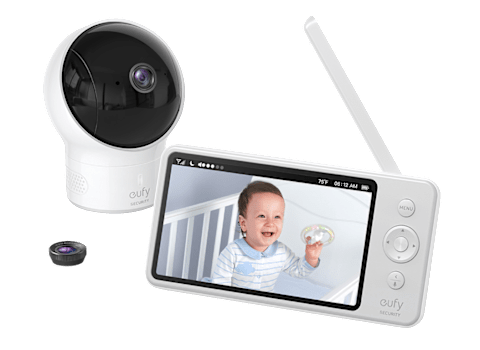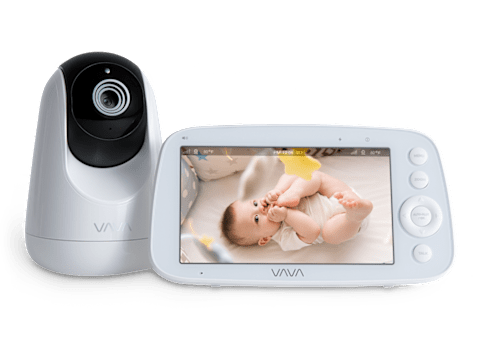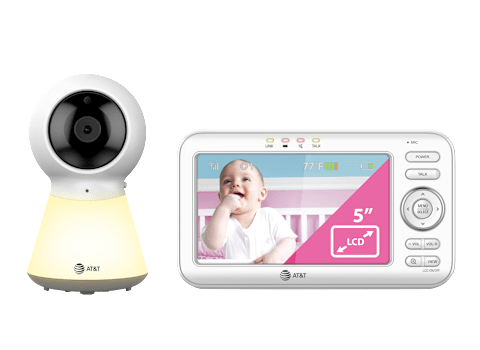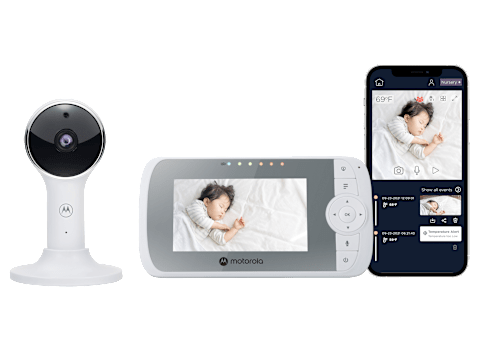Best Baby Monitors
We tested models from Nanit, Owlet, Vava, V-Tech, and other top brands. Here are the ones that do best on ease of use, privacy, and security.

Some baby monitors, such as CR-tested models from Vava and Eufy (foreground, left) come with separate screens for watching your baby, while monitors like the Miku Pro Smart (right) send the video to a phone app.
By Allen St. John
Parenthood is a 24-hour-a-day job and, as most new parents quickly realize, you’re not off-duty even when your infant is asleep. That’s where a baby monitor comes in handy, helping parents and caregivers unobtrusively keep tabs on a little one who is sleeping . . . or just waking up. Because for many babies, opening a bedroom door is an automatic wake-up call.
Consumer Reports just finished testing 10 of the most popular baby monitors on the market, from Eufy, Microsoft, Owlet, Vava, VTech, and other popular brands. They range in price from about $40 to $400, but our testers find little correlation between cost and performance. You can get a solid pick for under $100.
Nearly all baby monitors have a camera and mic that stay in the baby’s room. (There’s currently just one audio-only model in our baby monitor ratings.) Many models also let you talk to the child through the monitor or even play a lullaby. Typically, you can buy a second camera that you can monitor on the same screen if you’ve got more than one small child. Most baby monitors can use an infrared function that allows you to watch the baby even when the room is dark, albeit in black and white.
When it comes to watching the video feed, baby monitors fall into two broad categories. Some models transmit the sound and visuals via radio waves to a receiver unit that you can carry with you from room to room. The second type of baby monitor doesn’t come with a receiver, but instead connects to WiFi, and sends the audio and video through the internet to the manufacturer’s servers, and then to your smartphone. Each type has benefits and drawbacks.
Models that use your smartphone as the display are convenient since most of us carry our phones around with us at all times. If you’re out on a date night or at work, you can check in on your baby directly, instead of just asking the caregiver for a report.
However, baby monitors that come with a separate display unit have an advantage when it comes to security. The video feed stays local, in your home. That means the feed is less likely to get hacked—something that has happened from time to time, though it’s rare. And the manufacturer can’t access the video and other information that can be gleaned from the device, either.
Consumer Reports tested baby monitors on factors, including ease of use and the quality of the video feed. But we put the internet-connected baby monitors through additional evaluations because of potential risks. Most of them received middling marks for both security against potential hacking, and for privacy—how the companies collect and handle data from the devices.
Security and Privacy: What We Found
To evaluate security, our testers used the same protocol that we use for wireless security cameras. Only the Nanit Pro, the Owlet, and the Motorola VM64 (the one model we tested with both a separate display and smartphone capability) earn strong scores for security. And even these three baby monitors fall short of CR’s top-rated security cameras.
The most common security problems we found were less-than-secure log-in rules, meaning that the devices don’t all require complex passwords or multifactor authentication. In fact, Motorola, Owlet, and Lollipop don’t even support multifactor authentication, which can be an important protection against someone accessing your account if they acquire your password.
We also found relatively low-risk security vulnerabilities that were specific to certain models, and contacted the companies involved. The companies addressed the problems, with the exception of Lollipop, which never responded to repeated attempts by Consumer Reports to get in touch. The Lollipop vulnerability was somewhat more serious than the others. Without describing it in detail, we can say the vulnerability could allow a sophisticated, determined attacker to remotely take control of certain functions of the device.
On the privacy front, only some of the manufacturers provided clear information in the user documentation on how they collect and use data, and how long they keep it. Just three companies—Motorola, Nanit, and Owlet—say they’ll let you get a copy of the data they’ve collected as you set up and use their baby monitors. On a more positive note, all of the companies other than Miku say you can contact them to have them delete the data they’ve collected.
Overall, just one internet-connected device—the Nanit Pro camera—scores high enough on security and privacy, in combination with its other scores, to earn an overall CR recommendation.
If you do opt for the convenience of a smartphone-connected device, here are some easy steps you can take to make it more secure.
- Use a complex password. Some of the devices allow you to use a short, six-character password, but our privacy experts urge you to use at least eight characters with a mix of letters, numbers, and other characters. (See our password manager ratings and buying guide.)
- Enable multifactor authentication. Only the Miku and Nanit baby monitors offer this feature, which should really be standard on any important connected device or online account. MFA can prevent someone who gets your password from logging in to your account. Once you’ve set it up, you’ll also get a warning if someone with your credentials tries to log in from a new device.
- Routinely update the device’s firmware. The Miku and Motorola models we tested can perform automatic updates, but the models from Lollipop, Nanit, and Owlet require you to do it manually. Our experts suggest that you check for and perform firmware updates once a month to keep on top of security fixes and enhancements.
Physical Safety
Some parents, hoping for a better view of their sleeping child, may inadvertently install a baby monitor in an unsafe way.
The Consumer Product Safety Commission warns parents never to put a baby monitor in a baby’s crib or mount it on the crib rails. And most important, make sure electrical cords are at least three feet away from the crib to reduce the risk of strangulation, even if you have a very young infant. A few of the models that we tested come with a plastic conduit that can help secure the cord.
The Miku and Nanit monitors we tested claim they can track a baby’s breathing or movements and send a smartphone alert. Additionally, the Owlet baby monitor we tested comes with a sock that is supposed to monitor the baby’s breathing and oxygen level. Consumer Reports did not attempt to evaluate any of those functions.
Features to Look For in a Baby Monitor
Here are useful features that are found in many baby monitors:
- HD screen resolution: All of the video monitors we tested have color cameras (and screens, for the non-smartphone models), although in the dark, when the infrared mode is being used, they transmit in black and white. They range in resolution from a grainy 320p to a high-definition 1080p, but even the low-res models are adequate to see what your child is doing.
- Two-way talk: The monitors all have two-way communication that allows you to not only hear a baby’s noises, but enable you to talk back in a way that might reassure the youngster.
- Multiple cameras: All of the models we tested, except the V-Tech, offer the option of buying additional cameras feeding the same display, which can be useful if you’ve got more than one small child.
- Temperature sensors: The models we tested can report on the temperature in the child’s room. Some also add a humidity reading, which might be useful, say, if you’re running a vaporizer or humidifier in a sick child’s room.
Recommended Baby Monitors With Video
Eufy Spaceview

The Eufy comes with its own display and handles the video feed locally, so it doesn’t have the privacy and security issues of internet-connected models. Our testers report that the screen is bright, sharp, and relatively large, and they find it to be the easiest monitor to use.
Vava Baby Monitor (VA-IH006-4)

The mid-priced Vava model comes with its own display and handles the video feed locally, so it doesn’t have the privacy and security issues of internet-connected models. The display unit has a large, bright, high-resolution screen. This model does, however, lack some less important features, like a night light and the ability to play music. And the volume is controlled via a menu rather than physical buttons, which can be more convenient.
VTech VM5254

The V-Tech is the value choice in our group. This model comes with its own display and handles the video feed locally, so it doesn’t have the privacy and security issues of internet-connected models. The monitor has a lower resolution than its more expensive rivals, but that’s probably not a major problem for most users. It is also packed with extras like a night light and the ability to play lullabies to soothe a child to sleep. Parents with more than one infant should note that it’s the only model in our test that can’t support a second camera.
Nanit Pro Camera

The Nanit lacks its own display. Instead, it transmits the video and audio through the company’s servers to an app on your smartphone. It has the highest overall rating of any of the models with this configuration and is the only one to earn a CR recommendation. However, it still falls short of the best wireless security cameras in privacy and security.
Motorola VM64

This Motorola baby monitor doesn’t earn a CR recommendation, largely because it doesn’t score well in ease-of-use evaluations. But we’re including it here because it has a unique feature. This model comes with a display, so you can use it without connecting it to the internet. However, it can also be used with a smartphone when you want to check in on the baby when you’re away from home. This gives you the best of both configurations. It performed fairly well in CR’s privacy and security evaluations.
Consumer Reports is an independent, nonprofit organization that works side by side with consumers to create a fairer, safer, and healthier world. CR does not endorse products or services, and does not accept advertising. Copyright © 2023, Consumer Reports, Inc.
